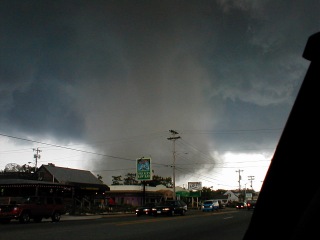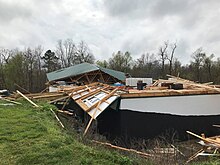Portal:Tornadoes
Note: Tornadoes are very dangerous and potentially deadly. Always take tornado warnings seriously and immediately seek shelter. |
The Tornadoes Portal

Selected tornado article -
Selected tornado list -
From January to March 2017, various weather forecast offices of the National Weather Service confirmed at least 399 tornadoes across the United States, activity well beyond climatological norms. Based on the 1991–2010 average, the first month of the year is expected to see 35 tornadoes, with 29 occurring in February and 80 forming throughout March. In 2017, however, the count for the first three months was 135, 70, and 194, respectively. Activity began with the development of an EF1 tornado north of Jasper, Texas at 15:03 UTC on January 2. The latest storm of the period was an EF1 that touched down southeast of Powellsville, North Carolina at 22:15 UTC on March 31. The strongest tornado, an EF4, carved a path of destruction from Perryville, Missouri to southwest of Christopher, Illinois. Meanwhile, the deadliest tornado of the period was of EF3 intensity that destroyed a mobile home park south of Adel, Georgia, killing 11 people.
The first month of the year featured the second-highest tornado count on record, surpassed only by 1999. A total of 135 tornadoes were confirmed, resultant from two major outbreaks that affected the United States on January 2 and from January 21–23. The latter event was the second-largest January outbreak on record (with 81 confirmed tornadoes), second to January 21–23, 1999, and the third-largest wintertime outbreak, excelled only by the aforementioned incident and the 2008 Super Tuesday tornado outbreak. In addition, the outbreak led to 42 tornadoes in the state of Georgia, upending the previous record of 25 set during 2004's Hurricane Ivan. Twenty people were killed from January 21–23, the second-highest count during a January event to the 1969 Hazlehurst, Mississippi tornado outbreak. February, meanwhile, featured 70 tornadoes, a count well below that of the preceding month's but still over twice the long-term average. An outbreak on the final day of February into the first day of March produced 72 tornadoes and 4 fatalities. On the back of that outbreak, an event of 63 tornadoes across similar areas a week later, and continued activity in the weeks following, March observed a total of 194 tornadoes. (Full article...)Selected image -

Selected tornado year -
Related portals
2024 tornado activity
Tornado anniversaries
May 22
- 1987 – A short-lived but devastating F4 tornado destroyed 85% of Saragosa, Texas, killing 30 people, including 22 in building where a Head Start graduation was about to take place. Many of the dead were parents or grandparents who died shielding the children from debris.
- 2004 – An F4 tornado caused major damage in and near Wilber and Hallam, Nebraska, killing one person and injuring 28. At one point the tornado was 2.5 miles (4.0 km) wide, making it, at the time, the widest tornado ever recorded. This record was later surpassed by the 2.6-mile (4.2 km)-wide 2013 El Reno tornado.
- 2011 – A catastrophic EF5 tornado devastated the southern portions of Joplin, Missouri, killing 158 people and injuring 1,150. It was the deadliest tornado to hit the United States since 1947 and the costliest in U.S. history with $2.8 billion in damage.
May 23
- 1878 – A long-track F4 tornado killed 17 people in a track across Iowa and Dane Counties, Wisconsin with major damage in and near Mineral Point. At least four others were killed by tornadoes in Wisconsin and Illinois.
May 24
- 1973 – A highly-visible F4 tornado hit Union City, Oklahoma, killing two people. This was one of the intensely studied tornadoes in scientific history. For the first time, Doppler weather radar detected the circulation of the tornado before it touched down, a significant advancement in tornado forecasting. This was also the first time that scientists had documented the entire life cycle of a tornado in detail.
- 2011 – An extremely intense EF5 tornado passed near El Reno and Piedmont, Oklahoma, killing nine people and injuring 181. Mobile Doppler radar recorded wind speeds of up to 295 miles per hour (475 km/h). A tanker truck was thrown a mile (1.6 km) and a 1.9-million-pound (860,000 kg) oil rig was rolled three times. Two high-end EF4 tornadoes passed near Blanchard and Washington, Oklahoma. The Blanchard tornado may also have reached EF5 intensity.
Did you know…
- ...that the 2013 Moore tornado that struck Moore and Newcastle, Oklahoma, is the most recent EF5 tornado?
- ...that the 2021 South Moravia tornado, an IF4 tornado with winds between 207–260 mph (333–418 km/h), was the strongest tornado to hit the Czech Republic in modern history?
General images -
The 2006 Westchester County tornado was the strongest and largest tornado in Westchester County, New York since the 1904 Chappaqua tornado. It touched down there on Wednesday, July 12, 2006, and traveled 13 miles (21 km) into southwestern Connecticut during a 33-minute span through two states. The tornado touched down at 3:30 p.m. EDT (19:30 UTC) on the shore of the Hudson River before becoming a waterspout and traveling 3 mi (5 km) across the river. Coming ashore, the tornado entered Westchester County and struck the town of Sleepy Hollow at F1 intensity. After passing through the town, it intensified into an F2 tornado and grew to almost a one-quarter mile (400 m) in diameter. The tornado continued through the county, damaging numerous structures, until it crossed into Connecticut at 4:01 p.m. EDT (20:01 UTC). Not long after entering the state, it dissipated in the town of Greenwich at 4:03 p.m. EDT (20:03 UTC). When the tornado entered Westchester County, it was the eighth known tornado to either touch down or enter the county since 1950.
Two barns and a warehouse were destroyed, and a large stained-glass window was shattered. Numerous homes and businesses were damaged and thousands of trees were uprooted. There were no fatalities and only six minor injuries were associated with the storm. The cost of damages was estimated at $12.1 million. (Full article...)List of Featured articles and lists
|
|---|
Topics
Subcategories
Related WikiProjects
The scope of WikiProject Severe weather is to write articles about severe weather, namely thunderstorms and tornadoes. Their talk page is located here.
WikiProject Weather is the main hub for all articles that are weather-related. WikiProject Weather strives to improve articles in a variety of weather topics, including Tropical Cyclones, Severe Weather, General meteorology, Non-tropical Storms, Climate, Floods, Droughts and wildfires, Meteorological instruments and data, Meteorological Biographies, and Space Weather. If you would like to help, please visit the project talk page.
WikiProject Meteorology is a collaborative effort by dozens of Wikipedians to improve the quality of meteorology- and weather-related articles. If you would like to help, visit the project talk page, and see what needs doing. The project is currently being merged into WikiProject Weather.
WikiProject Tropical cyclones is a daughter project of WikiProject meteorology. The dozens of semi-active members and several full-time members focus on improving Wikipedia's coverage of tropical cyclones.
Wikipedia is a fully collaborative effort by volunteers. So if you see something you think you can improve, be bold and get to editing! We appreciate any help you can provide!
Things you can do
Wikimedia
The following Wikimedia Foundation sister projects provide more on this subject:
-
Commons
Free media repository -
Wikibooks
Free textbooks and manuals -
Wikidata
Free knowledge base -
Wikinews
Free-content news -
Wikiquote
Collection of quotations -
Wikisource
Free-content library -
Wikiversity
Free learning tools -
Wikivoyage
Free travel guide -
Wiktionary
Dictionary and thesaurus










































